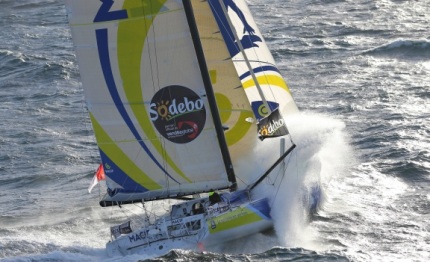VENDEE GLOBE
Vendée Globe: Reality bites

redazione
Rather than the strong gales which often prevail on the Bay of Biscay it was irregular, unsettled winds and big squalls which set a high work rate for the solo skippers through their first night of the Vendée Globe solo race around the world.
Sailing a direct SWly course from Les Sables d’Olonne to pass Cape Finisterre, the first 24 hours of racing have been a straight boatspeed test, dealing with big, at times confused seas and using the variations in both wind strength and direction to best effect. But the rewards for those at the front of the fleet will be greatest as they will reach the fast downwind conditions of the Portuguese tradewinds soonest.
As the leaders passed the infamous Cape Finisterre late this afternoon it remains Francois Gabart on Macif who has already built a useful margin, sailing consistently quicker than his nearest rivals. During the late evening hours of Saturday, Gabart and Armel le Cléac’h, sailing sister-ship Banque Populaire, were consistently 1 to 1.5 knots faster.
Briton Sam Davies is just one of the skippers who found the variable breezes tough, with big squalls bringing very heavy rain. She reported that she had seen everything from seven to more than 40 knots of wind during the night.
Steadily the gaps have opened in the 19 boat fleet as reality bites. As it stands now it is a clutch of the newest boats, driven by a posse of skippers who have trained hardest as a group which are setting the pace. Gabart’s lead on the late afternoon, 1500hrs UTC rankings, was at 11 miles ahead of Vincent Riou on PRB who had 1.1 miles in hand over third placed Le Cléac’h.
The leading trio have established a cushion of 12 miles to Switzerland’s Bernard Stamm on Cheminées Poujoulat. Briton Alex Thomson on Hugo Boss is starting to show his customary pace, polled fastest of the fleet this afternoon along with Jean-Pierre Dick on Virbac-Paprec 3. Thomson had risen to fifth place this afternoon and had less than one mile to catch Stamm. He will be quietly pleased to have passed the point where he had to turn back in the 2008-9 race when he suffered hull damage. This trio now compose a second group, at around 24-25 miles behind the leaders.
Another 12 miles back Jean Le Cam in seventh heads a third pack of boats with six miles separating his SynerCiel from Mike Golding in Gamesa in tenth.
Guillemot retires
The Vendée Globe habitually seems compelled to deal the toughest blows to some of the nicest, most popular and deserving skippers.
After enduring one of the most compelling races of the last edition – standing by the injured Yann Eliès, repeatedly climbing his mast to try and fix a damaged mast track which meant he sailed much of the course with two reefs in his mainsail and then sailing the last 1000 miles to finish in third place into Les Sables d’Olonne with no keel - after it snapped off - Marc Guillemot might have considered he had earned the right to better luck this time.
But the Safran skipper became the first to be forced out of this Vendée Globe when his titanium fin keel snapped off less than six hours into this race. Inspection back in the start port this morning revealed that just 30cms of the keel stub remained. Guillemot reported hearing two bangs in quick succession before his IMOCA Open 60 heeled alarmingly.
“I don’t know if we hit something or not. We are trying to know what happened. We will tell you what we discover. We won’t hide anything.” Guillemot told a press conference in Les Sables d’Olonne this morning.
“The keel had done between 23,000 and 25,000 miles. We trained with it before the last Transat Jacques Vabre in 2011, we did the B2B, went around the British Isles, and then four or five thousand miles in conditions which were not always easy. So, given that all it had been through, I left with confidence and no competitor would consider leaving without a lot of confidence in your keel.”
Since starting his race at around 0300hrs local time this morning Bertrand De Broc has been facing a more complex weather picture than had been gifted to the other 18 Vendée Globe soloists. The French skipper had to about-turn and go back to port before he had even started the race in order to make an express repair on a small puncture hole in the hull of his Votre Nom Autour du Monde avec EDM Projets.
Photo: JEAN-MARIE LIOT
11/11/2012 22:48:00 © riproduzione riservata
Tweet
CORRELATI
DELLA SETTIMANA
Lega Navale Italiana, un anno da record: superati i 63.800 soci nel 2025
In crescita rispetto allo scorso anno il numero di socie (+2300), di soci under 25 (+1200) e la comunità sui social media della LNI, con oltre 45000 follower. Il Presidente Marzano lancia gli Stati Generali 2026
Vincere overall? Ci vuole un JPK
Il cantiere francese protagonista di tantissime importanti regate che hanno consentito ai proprietari splendide prestazioni in tempo comprensato. Anche per Min River, un JPH 10.30, una vittoria epica alla Rolex Sydney Hobart 2025
Un'ottima Sydney/Hobart per l'IY 12.98 "Veloce"
"Veloce", timonata da Matt Hyes, conclude al 33° posto in tempo reale, 10ma overall e 4a nella Classe 1, confermando la qualità e le alte prestazioni delle barche del cantiere italiano
Sydney Hobart: la spunta Comanche in un finale al cardiopalma
Master Lock Comanche, con Matt Allen al timone, ha conquistato le line honours della 80ª Rolex Sydney Hobart imponendo compostezza e lucidità
Optimist: torna a Napoli dal 4 al 6 gennaio il Trofeo Campobasso
Sarà il Trofeo Marcello Campobasso ad aprire il programma di eventi di Napoli Capitale Europea dello Sport 2026 con la 32esima edizione della storica regata internazionale della classe Optimist, in programma dal 4 al 6 gennaio
Sodebo Ultim 3 e The Famous Project CIC verso la storia del Trofeo Jules Verne
Sodebo Ultim 3 di Thomas Coville e The Famous Project CIC di Alexia Barrier e Dee Caffari, stanno scrivendo pagine indelebili nella corsa al Jules Verne Trophy con entrambi i maxi-trimarani lanciati a tutta velocità nei Mari del Sud
Bye Bye Point Nemo, si va a Capo Horn!
L'equipaggio del maxi-tri The Famous Project CIC si dirige verso Capo Horn in un mare fortemente agitato. Alexia Barrier: "Capo Horn non si conquista attaccando di petto, ma con costanza”
